VERIFICATIONS OF EMPIRICAL METHOD AND NUMERICAL SIMULATION USING PHYSICAL MODEL FOR SUBSIDENCE PREDICTION OF MAHA SARAKHAM FORMATION
Main Article Content
Abstract
Physical model tests are performed to verify the representativeness and accuracy of the hyperbolic, exponential and trigonometric profile functions that have been widely used to define the ground surface subsidence under sub-critical to critical conditions, induced by potash and salt mine openings. Numerical simulations using FLAC program are also performed to confirm the correctness and reliability of the physical model test results. Synthetic gel mixed with paraffin additive is used to simulate the overburden for the physical model test. Based on the similarity theory the gel properties, and the opening models can be defined as the prototype that is equivalent to the Maha Sarakham formation. The results obtained from the physical model test agree well with those for the numerical analyses, suggesting that the laboratory test simulations are reliable and correct. The angle of draw and maximum subsidence exponentially increase with opening width. Both decrease with increasing opening depth. The hyperbolic and exponential functions overestimate the slope of the surface profile, as compared to those of the laboratory measurements for all opening depths. The trigonometric function overestimates the volume of the subsidence trough. Application of the hyperbolic function would be a conservative approach for prediction the surface subsidence size and slope for sub-critical to critical conditions.
Article Details
The published articles are copyright of the Engineering Journal of Research and Development, The Engineering Institute of Thailand Under H.M. The King's Patronage (EIT).


